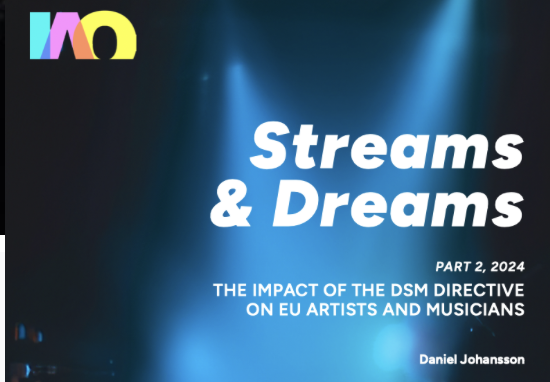A fascinating study written by Daniel Johansson of the Inland Norway University of Applied Science entitled “Revenue Distribution From Music Streaming – A Quantitative Analysis of Swedish Artists on Spotify” has been published and is available here.
Assessing the winners and the losers in the world of streaming, lessons can be learned for artists throughout Europe and beyond.
Do we want the revenue generated by Spotify and other DSPs to go to fake artists ‘creating’ making “white noise” recordings or is it time we found a way to make sure the money gets to those who deserve it, the creators and artists?
Scope of the study: what it covers
The study analyses all Swedish artists that have generated more than 1 million streams on Spotify since its release in 2008, gathers data for every track available from each artist and shows how individual genres have performed. Carrying out simulations of revenue generated by different categories of artists, it can (subject to certain limitations) show who are the winners – and who are the losers – in the Swedish Spotify streaming economy.
The study starts by stressing the need for a better understanding of the economics of streaming. The author examines the way the streaming model operates and provides a detailed explanation of e.g. why there is no such thing as a “per-stream rate”.
In order to carry out a number of simulations regarding revenue that might be received by various categories of artists, with various different types of record deal, he creates a model with a constant stream rate which is applied to the data collected.
The results are very revealing. Jazz, metal and classical artists fare very poorly, while artists in “niche” local language genres such as “epadunk” do very well, as do “playlist-friendly” newage/ambient artists
However, the simulation which shows the most profit is that of the “noise artist”, producing recordings of white/brown/pink etc noise. These are recordings of low frequency sounds, often designed for relaxation, concentration or sleep. One such “artist” can be estimated as generating more than $100,000 per month.
Scope of the study: what it does not cover
One of the most commendable aspects of this study is that it is aware of its own limitations. Without knowing the details of individual contracts between a record label and an artist, it is impossible to tell what amount the artist actually receives after the revenue they generate via Spotify has filtered through the label’s contractual labyrinth. As the author states, his simulations by necessity cannot take into account “advances and fixed costs like recording expenses, marketing, overhead costs and other details that are also a part of artist contracts”. The results of the simulations would of course be different if such things had been able to be taken into account, as the author acknowledges.
However, the author does make reference to the Music Creators’ Earnings in the Digital Era Study, which provides an insight into major label contractual practices.
– Record label contractual practices
The Music Creators’ Earnings study reveals the content of a 2020 Sony Music Featured Artist royalty
contract. Its provisions include: – Overheads
Under this contract, before any royalties are paid to the artist, Sony Music deducts 25% of gross revenue generated, which it uses to “cover its overheads”. It is remarkable that, as the study notes, “while a label’s overheads are fixed, the contribution that each release makes to those overheads will be based on 25% of that release’s gross revenue and will therefore rise as its revenue rises.”
– Marketing
This surreal situation with overheads is nothing when compared with the provisions regarding deductions made for marketing. 15% of gross revenue generated is deducted to cover “marketing” costs. This would be understandable were it to apply to e.g. the first year that the recording was released. However, these deductions are made throughout the entire life of the recording. For 70 years, 15% of revenue otherwise payable to the artist, will be deducted, disguised as marketing expenses, when of course no marketing whatsoever will actually occur for the vast majority of that time. Such practices may be legal, but they may also be deemed misleading and immoral.
– Investment by the artist
The author also does not have access to another vital component necessary to fully understand the artist’s position in streaming today. The investment made by an artist, both in terms of finance and time, is greater than ever before. An artist now needs to purchase equipment that will enable themselves to create high quality recordings. They need to spend time and money writing the songs, crafting them, rehearsing them in rehearsal rooms, before finally recording them. They then need to distribute their initial recordings on social media and other DSPs and to maintain a presence in order to achieve a sizeable following.
These tasks and costs were previously borne by the record label, which is why, together with their role in the manufacture and distribution of physical records/CDs etc, it was logical that they should receive a significant share of the revenue generated by the recording and it was logical that they should be allowed to recoup some of these costs against the artist’s share of the revenue generated. However, applying the same logic today, an artist ought to be able to recoup the investment they have made in a recording from the label’s share of revenue generated.
It was also logical that a record label should be legally defined as the sole “producer” of a record and benefit from the valuable copyright protection granted to producers. The definition of “producer” in international copyright law (the WPPT) is:
Article 2 (d) “producer of a phonogram” means the person, or the legal entity, who or which takes the initiative and has the responsibility for the first fixation of the sounds of a performance or other sounds, or the representations of sounds.
A record label may still meet this definition in the case of for example pre-packaged talent show contestants that “win” a record contract and are provided with a song, musicians, and a studio in which to record it. In other cases, record companies certainly do not meet this definition.
It is true that artists today have the option of being a DIY artist however the prospects of being able to sustain a career via this route are extremely small. The numbers speak for themselves: a 2022 study by the UK competition authority (CMA) shows that of the top 1000 recordings released in 2021 in the UK, 98% of them were tied to either a major record or major publishing label.
A system whereby modern royalty rates, contracts and revenue-splits do not take into account the role of an artist as the producer of their own recordings, and the investment they make in those recordings, is entirely obsolete.
– Equitable remuneration
Although this study does not directly cover the question of the need or otherwise to introduce a right to equitable remuneration, its findings contribute to a growing body of evidence that overwhelmingly supports such a right.
That body of evidence includes a study entitled “Streams and Dreams – A Fair Music Economy For All”, conducted by the same author as this study, in which he recommends that we “make use of both the Spain/Belgium ER model and the France voluntary agreement model, and that they both need to be balanced towards each other in a hybrid solution including all actors around the negotiation table. They are not in conflict with each other, they should complement each other.”
What this new study does address is “fair remuneration”, noting the fact that “many more artists stand perplexed over how their artistry does not translate into a fairer remuneration, at the same time as the intermediaries between the artists and their audiences report immense profits year after year”.
It is no wonder that artists are perplexed. Record label executive “remuneration” – such as the one time stock grant of up to $100 Million (and yes, that is in addition to the $250 million package received in 2021) payable to the Universal Music Group’s CEO – is exhorbitant. Why some of that amount cannot be shared with artists is, indeed, “perplexing”.
Conclusions
In the conclusions of the study, the author asks: “is it perhaps now time to start tweaking the streaming model towards a system that better reflects the immense cultural value that artists provide to fans and society at large?”
Those who have the interests of artists and creators at heart would answer with a definite “yes” and agree with him when he concludes by saying that:
“DSPs, labels, PROs, publishers, distributors, as well as legislators and politicians, all need to jointly focus on the broader picture; how to better remunerate the ones that in fact are the most important and most valuable asset, the music creators and artists.”


